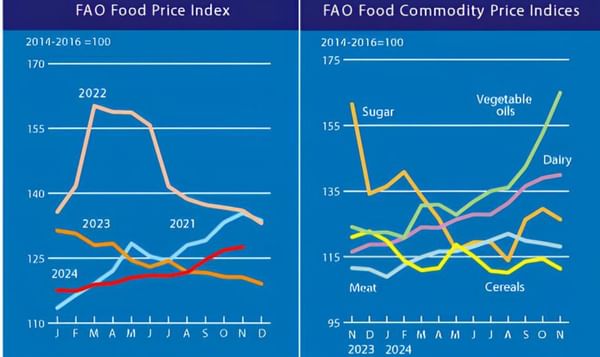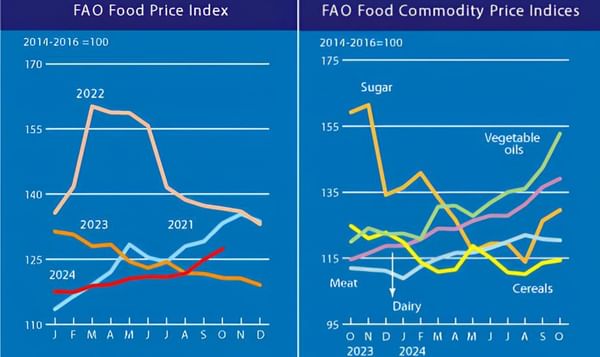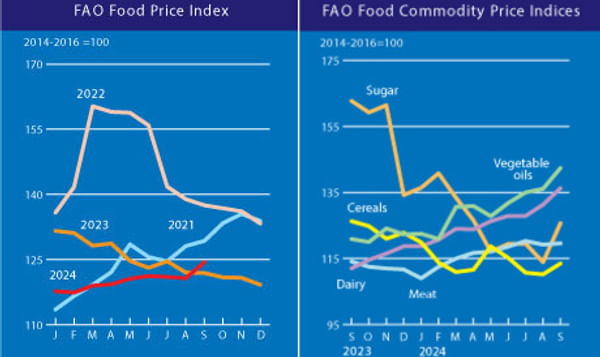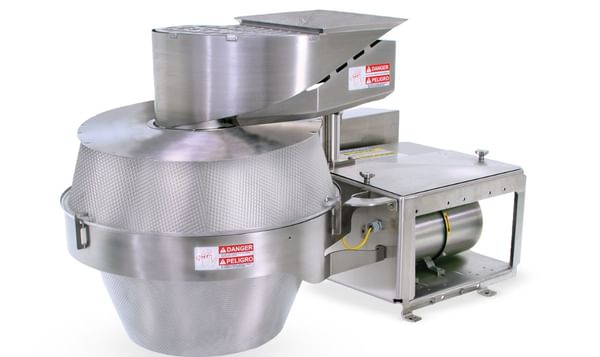The FAO Food Price Index (FFPI) averaged 173.5 points in April 2018, nearly unchanged from March but up 2.7 percent from the corresponding period last year.
FAO Food Price Index steady
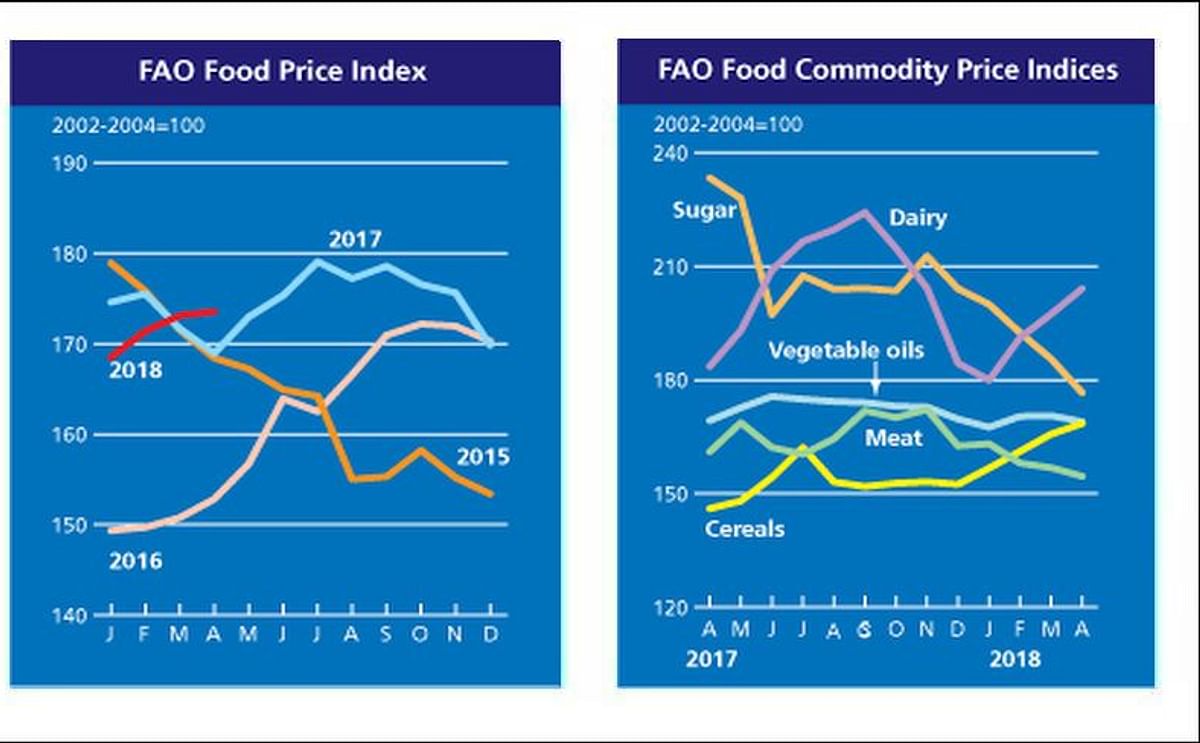
The FAO Food Price Index (FFPI) averaged 173.5 points in April 2018, nearly unchanged from March but up 2.7 percent from the corresponding period last year.
While the prices of most cereals and dairy products continued to increase in April, sugar prices fell further. Vegetable oil and meat markets also remained under downward pressure.
The FAO Cereal Price Index averaged 168.5 points in April, 1.7 percent (2.8 points) higher than in March and some 15.4 percent above its value in April 2017. The Index has followed an upward trend for the fourth consecutive month, with prices of wheat, coarse grains and rice all gaining momentum in recent months.
In the case of wheat, weather-related risks, especially in the United States, and robust trade provided support to prices, while expectations of lower plantings in the United States, on the backdrop of drought-reduced production in Argentina, continued to push up international maize prices.
Rice prices, on the other hand, increased, following a fresh round of public purchases by Indonesia and the launch of a state import tender by the Philippines.
The FAO Vegetable Oil Price Index averaged 154.6 points in April, entailing a 1.4 percent fall, month-on-month, which mainly reflects developments in the markets of palm, soy and sunflower oils.
International price quotations of palm oil (the oil carrying the highest weight in the index) declined on slowing demand growth and prospective seasonal production gains in Southeast Asia.
Meanwhile, soy oil values weakened further, reflecting persistently strong crushing levels among key producers. Conversely, sunflower oil prices firmed, fueled by expectations of tightening global export supplies.
The FAO Dairy Price Index averaged 204.1 points in April, up 6.7 points (3.4 percent) from March, representing the third successive month of increase. With this latest rise, the index is over 11 percent above its level in the corresponding month last year. The upward price trend reflects robust import demand for all milk products, combined with market apprehensions regarding export availabilities in New Zealand following a bigger than anticipated decline in its milk output.
The FAO Meat Price Index averaged 169 points in April, down 1.6 points (0.9 percent) from a slightly revised value for March. At this level, the index is almost equal to its value in April 2017. During the month, bovine and pigmeat prices decreased slightly, while those of ovine and poultry meat remained stable. Larger exports from the Americas underpinned the decrease in bovine meat prices, while slackened import demand caused pigmeat prices to ease.
The FAO Sugar price index averaged nearly 176.6 points in April, down 8.9 points (4.8 percent) from March and as much as 24 percent lower than its April 2017 value.
Continued declines in sugar price quotations since last December are largely a reflection of a supply glut in the sugar market, especially in view of record outputs in Thailand and in India, the world’s second largest sugar producing country. Additional downward pressure stemmed from a depreciation of the Brazilian currency (Real) with respect to the US Dollar, coupled with anticipated government support measures in India and Pakistan geared at boosting sugar exports.
While the prices of most cereals and dairy products continued to increase in April, sugar prices fell further. Vegetable oil and meat markets also remained under downward pressure.
The FAO Cereal Price Index averaged 168.5 points in April, 1.7 percent (2.8 points) higher than in March and some 15.4 percent above its value in April 2017. The Index has followed an upward trend for the fourth consecutive month, with prices of wheat, coarse grains and rice all gaining momentum in recent months.
In the case of wheat, weather-related risks, especially in the United States, and robust trade provided support to prices, while expectations of lower plantings in the United States, on the backdrop of drought-reduced production in Argentina, continued to push up international maize prices.
Rice prices, on the other hand, increased, following a fresh round of public purchases by Indonesia and the launch of a state import tender by the Philippines.
The FAO Vegetable Oil Price Index averaged 154.6 points in April, entailing a 1.4 percent fall, month-on-month, which mainly reflects developments in the markets of palm, soy and sunflower oils.
International price quotations of palm oil (the oil carrying the highest weight in the index) declined on slowing demand growth and prospective seasonal production gains in Southeast Asia.
Meanwhile, soy oil values weakened further, reflecting persistently strong crushing levels among key producers. Conversely, sunflower oil prices firmed, fueled by expectations of tightening global export supplies.
The FAO Dairy Price Index averaged 204.1 points in April, up 6.7 points (3.4 percent) from March, representing the third successive month of increase. With this latest rise, the index is over 11 percent above its level in the corresponding month last year. The upward price trend reflects robust import demand for all milk products, combined with market apprehensions regarding export availabilities in New Zealand following a bigger than anticipated decline in its milk output.
The FAO Meat Price Index averaged 169 points in April, down 1.6 points (0.9 percent) from a slightly revised value for March. At this level, the index is almost equal to its value in April 2017. During the month, bovine and pigmeat prices decreased slightly, while those of ovine and poultry meat remained stable. Larger exports from the Americas underpinned the decrease in bovine meat prices, while slackened import demand caused pigmeat prices to ease.
The FAO Sugar price index averaged nearly 176.6 points in April, down 8.9 points (4.8 percent) from March and as much as 24 percent lower than its April 2017 value.
Continued declines in sugar price quotations since last December are largely a reflection of a supply glut in the sugar market, especially in view of record outputs in Thailand and in India, the world’s second largest sugar producing country. Additional downward pressure stemmed from a depreciation of the Brazilian currency (Real) with respect to the US Dollar, coupled with anticipated government support measures in India and Pakistan geared at boosting sugar exports.
¿Te gustaría recibir noticias como esta por correo electrónico? ¡Únete y suscríbete!
Únete a nuestra Telegrama ¡Canal para actualizaciones periódicas!
Empresa Destacada
Contenido Patrocinado
Contenido Patrocinado
Contenido Patrocinado
Contenido Patrocinado
Contenido Patrocinado



